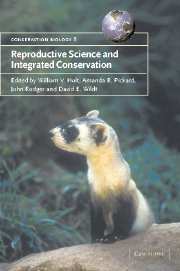Book contents
Part II - Reproduction and population viability
Published online by Cambridge University Press: 21 January 2010
Summary
There are more things in heaven and earth, Horatio, than are dreamt of in your philosophy.
(Hamlet: Shakespeare)Successful biologists, whether they like it or not, must have a wide spectrum of knowledge to make sense of their own scientific specialities, including the meaning of their own data. How would a pharmacologist or a microbiologist farewithout a background in biochemistry or cell function? Could an endocrinologist manage without having at least a rudimentary understanding of animal behaviour and physiology? The history of biology demonstrates that before the microscopic complexity of even the smallest life forms was revealed by pioneers such as Boyle, Malpighi and Leeuwenhoek, scientists more often than not simply made wrong conclusions. The spontaneous generation of worms in putrefying meat, and the ‘discovery’ of a circulatory system for sap in plants are classic examples.
Many scientists today persist in turning away or, worse yet, deprecating subjects they find dull and difficult. We, the editors of this book, have become particularly aware of this problem in the conservation biology world. We argue that all of the life science disciplines are important in conservation science because it is the interconnectedness of data and resulting concepts that solves some of the most urgent issues in species preservation and management today. It seem silly and self-defeating that some in the conservation field are so narrowly focused on their species, habitat or disciplinary interest that they fail to appreciate important advances in other fields, even when these have a direct impact on their own research questions.
- Type
- Chapter
- Information
- Reproductive Science and Integrated Conservation , pp. 21 - 23Publisher: Cambridge University PressPrint publication year: 2002



